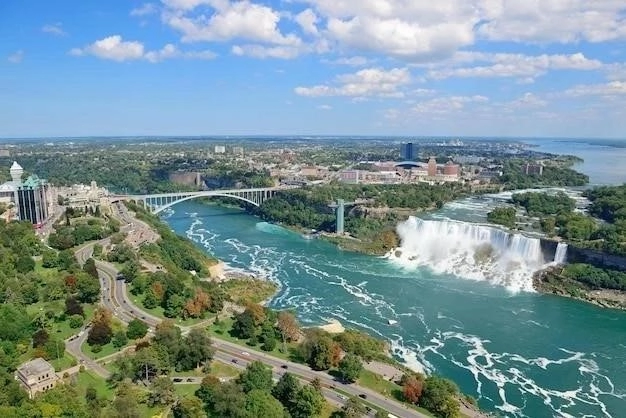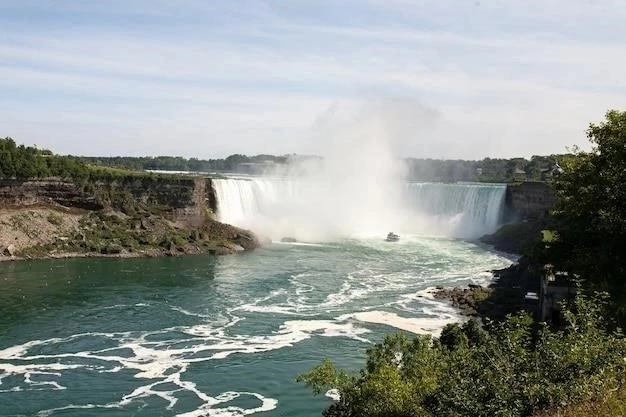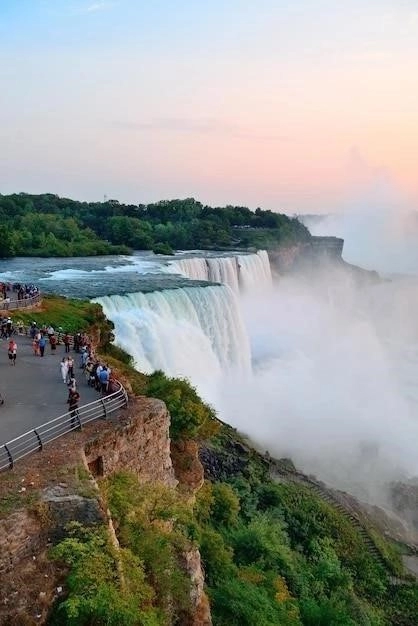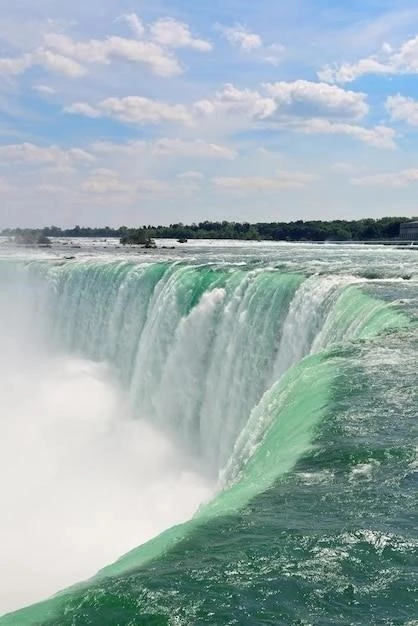Niagara Falls, a captivating spectacle of natures power and beauty, has captivated the hearts and minds of millions for centuries. Straddling the border between the United States and Canada, this iconic natural wonder draws visitors from every corner of the globe, eager to witness its awe-inspiring grandeur.

Geological Formation
The story of Niagara Falls begins over 12,000 years ago at the end of the last Ice Age, known as the Wisconsin Glaciation. As colossal glaciers retreated, they left behind a dramatically reshaped landscape, including the formation of the Great Lakes. Meltwater from these massive ice sheets carved out paths through the terrain, eventually giving birth to the Niagara River.
The key to Niagara Falls existence lies in the unique geology of the region. The Niagara Escarpment, a steep cliff formed over millions of years, plays a crucial role. The escarpment is composed of different layers of rock, with the top layer consisting of hard, erosion-resistant Lockport Dolostone overlying softer, more easily eroded Rochester Shale.
As the Niagara River flowed northward, it encountered the Niagara Escarpment. The softer shale eroded more quickly than the harder dolostone, creating an overhang. Over time, this overhang collapsed, causing the falls to retreat upstream. This process of erosion and retreat continues to this day, albeit at a slower rate due to engineering efforts.

The Three Falls
Niagara Falls isnt just one waterfall but a collection of three distinct cascades:
- Horseshoe Falls: The largest and most powerful of the three, Horseshoe Falls lies primarily on the Canadian side of the border. Its curved crest resembles a horseshoe, giving it its name.
- American Falls: Situated on the American side, the American Falls is wider than Horseshoe Falls but carries a smaller volume of water. Goat Island separates the American Falls from Horseshoe Falls.
- Bridal Veil Falls: The smallest of the three, Bridal Veil Falls is also located on the American side. It is separated from the American Falls by Luna Island and gets its name from its delicate, veil-like appearance.

Erosion and Future
Erosion is a natural process that has shaped Niagara Falls over millennia. While the rate of erosion has slowed due to human intervention, it is estimated that the falls have retreated approximately seven miles upstream since their formation. This ongoing process raises questions about the future of this natural wonder.
Geologists predict that if erosion continues at its current pace, Niagara Falls could eventually cease to exist as we know it. The falls could erode back to a point where the Niagara River no longer plunges over a significant drop, transforming into a series of rapids.
Human Impact and Preservation
The beauty and power of Niagara Falls have long captivated the human imagination, but they have also been subject to human impact. Early industrialization harnessed the power of the falls for hydroelectric power generation, significantly altering the surrounding landscape.
In more recent times, efforts have been made to mitigate human impact and preserve the natural beauty of Niagara Falls. International agreements between the United States and Canada aim to manage water flow over the falls, balancing the needs of hydroelectric power generation with the preservation of this natural wonder.

Conclusion
Niagara Falls stands as a testament to the power of nature, a symbol of both enduring beauty and constant change. Its geological history, marked by glacial activity, erosion, and the interplay of different rock formations, has created a spectacle that continues to inspire awe and wonder. As we marvel at its grandeur, we are reminded of the importance of understanding and preserving the natural world for generations to come.
Beyond the Spectacle: Niagara Falls Impact and Significance
While the visual grandeur of Niagara Falls undeniably reigns supreme, its significance extends far beyond its aesthetic appeal. The falls represent a confluence of geological history, ecological diversity, and human ingenuity, all interwoven to create a site of immense value.
A Biodiversity Hotspot
The Niagara Escarpment, the geological formation responsible for the falls, is recognized by UNESCO as a World Biosphere Reserve. This designation underscores the regions rich biodiversity and unique ecosystems. The varied topography, microclimates, and geological history have fostered a diverse array of flora and fauna, some of which are found nowhere else on Earth.
The Niagara Gorge, carved by the relentless force of the falls over millennia, provides a habitat for a variety of plant and animal species. Peregrine falcons, once endangered, now nest along the gorge walls, while the surrounding forests teem with migrating songbirds. The falls mist creates a unique microclimate that supports a lush understory of ferns and mosses, adding to the ecological richness of the area.
A Source of Power and Progress
Beyond its ecological significance, Niagara Falls played a pivotal role in the industrial development of both the United States and Canada. The immense power of the falls was harnessed for hydroelectric power generation in the late 19th and early 20th centuries.
Visionaries like Nikola Tesla recognized the potential of the falls to generate clean, renewable energy. The construction of hydroelectric power plants at Niagara Falls marked a turning point in history, providing a reliable source of power that fueled industrial growth and urban development. The legacy of this early hydropower development is still evident today, as Niagara Falls remains a significant source of renewable energy for the region.
A Symbol of International Cooperation
Located on the border of two nations, Niagara Falls also serves as a powerful symbol of international cooperation. The shared responsibility for managing and preserving this natural treasure has fostered collaboration between the United States and Canada on issues related to environmental protection, tourism, and resource management.
The creation of binational organizations, such as the Niagara Falls Illumination Board, demonstrates the commitment of both countries to working together to showcase the beauty of the falls while ensuring its long-term sustainability.
Conclusion: A Legacy for Future Generations
Niagara Falls stands as a powerful reminder of the awe-inspiring forces of nature and the importance of preserving our planets natural wonders. Its geological history, ecological diversity, and historical significance make it a site of global importance, deserving of our admiration, respect, and unwavering commitment to its preservation. By studying its past, appreciating its present, and safeguarding its future, we ensure that generations to come will be inspired by the timeless beauty and power of Niagara Falls.










